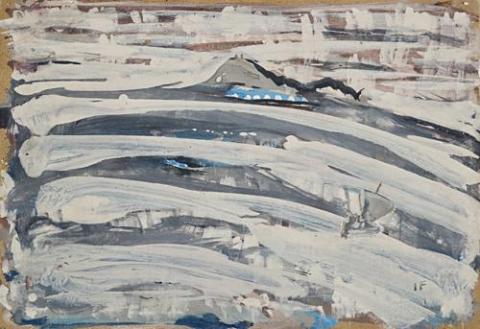VOYAGE TO BALI, 1957
Ian Fairweather
gouache on card
37.0 x 53.5 cm
signed lower right with initials: IF
Christie's, Sydney, 3 October 1972, lot 65
The Estate of Pro Hart, Broken Hill, New South Wales
Voyage to Bali by Ian Fairweather presents an absorbing interplay between the figurative and the abstract, capturing the best of both. The small boat of adventure in the right foreground recalls his own perilous journey by raft from Darwin to Bali in 1952, the broad expanse of sea crowned by the mountainous rise of the island, separating the infinity of the waters from those of the heavens. The freedom of his paint-laden brushstrokes, applied spontaneously, are the fruits of meditative consideration, marrying motif with metaphor. The contemplative balances the abstract-expressionist gestures of paint - a central feature of Fairweather's art, for, whatever the movements of the brush, serenity lies at its heart.
While Voyage to Bali has its pictorial antecedents in landscapes of the East, such as the oil, Near Hangchow, 1938, in the collection of the National Gallery of Australia, Canberra, or the gouache, Landscape, 1948, (plate 44), it draws on one of the most adventurous journeys in his life.1 Murray Bail, in his excellent study on the artist, tells us that 'Fairweather's paintings are above all meditations upon experiences, and the sixteen-day voyage was nothing if not a solitary encounter with madness and death.'2 He painted five related recollections, including this work and the 1957 gouaches Lights, Darwin Harbour, (plate 49), and Roti (fig. 49). All are aerial views, with the triangular raft as in this work. Returning to Australia in 1953, Fairweather settled at Bribie Island, where, in isolation, his work grew in confidence and individuality.
Moving towards a greater abstraction, the hermit-like life-style gave him the tranquillity in which to recollect and record objectively the emotions of the voyage. In Voyage to Bali the sea and sky are so vast that they dominate even the island's peaks, a microcosm of the universe in which man is minute. Yet the mood of the painting is one of optimism, drawing on experience beyond the merely tangible, of that which is seen inwardly. Within the expanse of sea and sky, the mood is intimate and touched with a newfound serenity. Through the magic of his brush the subject of a small raft alone on the seas transcends verisimilitude for the greater reality, giving his art that deep spirituality that is a central part of the unmistakable individuality of his art. As a master colourist, he exercised restraint in his use of colour, in this work enriched by the palimpsest echoes of colours brushed over.
1. The plate and figure references refer to illustrations in Bail, Murray, Ian Fairweather, Bay Books, Sydney, 1981
2. Bail, ibid, p. 111
DAVID THOMAS
We are grateful to Murray Bail for his assistance with this catalogue entry
